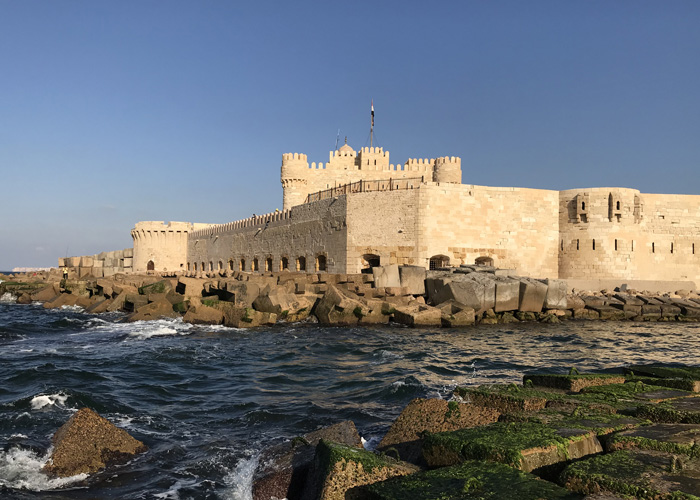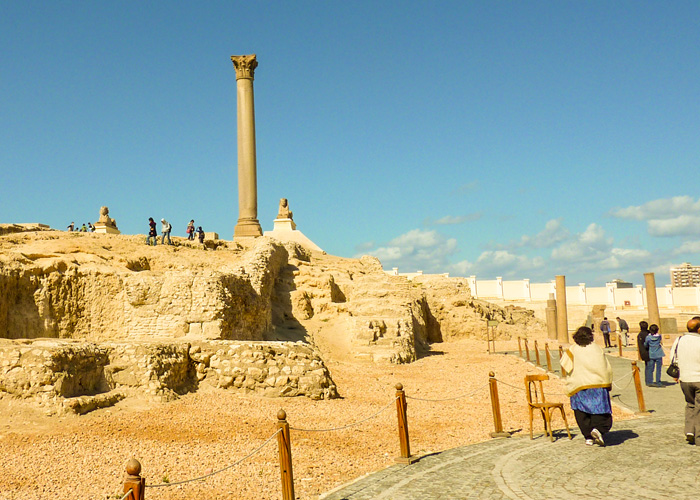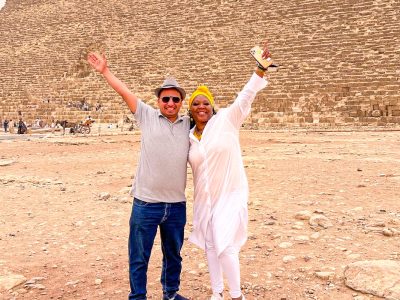Discover the best Alexandria Attractions offered by our All-inclusive Egypt Vacation Packages. Explore the city’s history and culture, from ancient ruins to beaches and monuments. With an array of activities and experiences, you’re sure to find something that piques your interest in this beautiful coast.
Alexandria attractions come from different cultures; the city is famous for its 20-kilometer square, palm-tree-lined boulevards, and elegant hotels. Its beautiful gardens and long sandy beaches. In particular, people in the Middle East think it is one of the most beautiful places to spend the summer.
Unlike many other places in Egypt, it has a Mediterranean feel due to its culture, the weather of the warm summers, mild winters, pleasantly warm springs, and fall, and its cosmopolitan vibe. Alexandria is often called the “Pearl of the Mediterranean” because of its beauty.
Check top tourist sights of Alexandria
Citadel of Qaitbay
The Citadel of Qaitbay is situated in the Egyptian capital of Alexandria. This monument serves as both a historical marker...
Read moreAlexandria’s magnificent library
The Library of Alexandria was the biggest in the ancient world, with over a million volumes. When Alexander the Great...
Read moreThe Roman Amphitheatre
The Roman Amphitheatre is one of the most prominent Greco-Roman structures in Egypt, and it was built in the first...
Read moreCatacombs of Kom El Shoqafa
In Alexandria, the catacombs of Kom El Shoqafa cemeteries are one of the most important historical archaeological sites in the...
Read moreMontaza Palace
Al Montazah Palace is one of the most distinguished buildings in Alexandria, and it is located in a location that...
Read morePompey’s Pillar
Pompey's Pillar is one of the few remaining remnants of Roman antiquity that can still be seen in the Egyptian...
Read moreGreco-Roman Museum
Despite its long history, Alexandria has a reputation for having very little to show for it. Cairo was constructed on...
Read moreThe Lighthouse of Alexandria was one of the Seven Wonders of the Ancient World; the Great Library was the most extensive in antiquity; and the Necropolis was one of the Seven Wonders of the Middle Ages.
Throughout the late 19th century and into the 1950s, Alexandria hosted a who’s who of writers, poets, and artists, garnering a rep as a hippy haven for tourists. One of the most incredible places to visit in Egypt to get a feel for the grandeur of yesteryear is Alexandria, despite the fact that, in contrast to Cairo and Luxor, there are very few actual ancient sites and things to do there.
-
The Citadel of Qaitbay
The Mamluke Sultan Qaitaibay constructed the Citadel of Qaitbay to protect this strategic Egyptian port from other assaults; he used rubble from the collapsed lighthouse in its foundation. As early as 1480, this short fort was keeping watch over Alexandria.
Several rooms with stone walls may be explored, and you can get a great view of the Mediterranean from the top, making it one of the main Alexandria tourist attractions.
-
The Library of Alexandria
The Bibliotheca Alexandrina is the city’s cultural hub and one of the top Alexandria tourist destinations. At its heart sits one of the world’s largest libraries and other museums devoted to preserving Alexandria’s rich history and culture.
Including the reading room, the main library’s interior can house eight million volumes.
-
The Roman Amphitheatre
The Roman Amphitheatre remains from the Greco-Roman era can be seen here, as the area is home to a small archaeological park. Apart from the theatre, other Roman-era buildings unearthed include baths and many villas.
-
The Pompey’s Pillar
The Pompey’s Pillar is one of the main Alexandria attractions; it is a nearly 27-meter-tall column of red Aswan granite with a Corinthian capital that was not erected in honor of Pompey but in 292 CE to commemorate Diocletian for providing food to the city’s starving populace following the siege.
-
Catacombs of Kom El-Shoqafa
The Catacombs of Kom el-Shoqafa can be found in the Carmous district, carved into the rock on the southern slopes of a hill. Dating back to the 2nd century CE, they are a great illustration of the unique blend of Egyptian and Greco-Roman styles characteristic of Alexandria attractions.
They were discovered in 1900 and consist of multiple tiers of sarcophagi and loculi (shelf tomb) chambers.
-
Montaza Palace
A visit to Montaza can do wonders for your sanity before you head back into the hustle and bustle of the city.
The Montaza Palace, with its towers reminiscent of Florentine architecture and Rococo flair, is off-limits to the public. Still, its expansive gardens are open to anyone and provide a welcome escape from the bustle of nearby Alexandria. Towards the park’s end on the shore is a little beach with a fanciful bridge leading to an even smaller island.
-
Alexandria Corniche
One of the main Alexandria attractions in the Heart of Downtown Alexandria, Near the Corniche, The broad, waterside Corniche Road in Alexandria is as much a symbol of the city as any landmark.
Walking along the Corniche, especially from the central waterfront area of Midan Saad Zaghloul to the Citadel of Qaitbey on the western edge of the Eastern Harbor, transports you back in time to the era of cosmopolitan elegance and decadence that defined this city in the late 19th and early 20th centuries.

We Are Travel Agency
Amon Ra Tours, Egypt’s travel experts, offer private, tailor-made tours, for families, small groups, and retreats. Get immersed in the Egyptian culture and history while receiving new perspectives from locals. When you book with us, you become family.
Our staff holds a plethora of not only historical knowledge, but day-to-day living to make your trip memorable.
WE HELP YOU PLANNING YOUR JOURNEY
| Trust and Safety | Beautiful Places |
| Best Travel Agent | Passionate Travel |
| Best Price Guarantee | Fast Booking |
Frequently Asked Questions.
Visitors to Egypt must enter with a passport valid for at least (6) months from the date of arrival. Most nationalities can have an entry visa valid for one (1) month from the date of arrival. Some of these countries are Australia, Canada, South Korea, Croatia, the United States, Georgia, Japan, Macedonia, Norway, New Zealand, European Union, Ukraine, the United Kingdom, Russia, Serbia, and most Latin American countries. This visa is acquired at the window before going through customs.
Since your tour guide will be a Spanish-speaking professional, it is not essential. However, it is beneficial to learn some of the most commonly used words and phrases. In case you wish to have contact with the locals and explore popular places, it will be necessary for you to know a few words.
While it is true that Egypt has a wealth of fascinating historical sites, the Nile River is not far behind. Aboard a cruise, you can experience navigating one of the most famous and history-filled rivers while watching the most beautiful sunsets that only Egypt has to offer. This is an experience like no other.
Taking pictures is allowed in most of the places to visit, however, some of these sites charge an additional fee for allowing you to do so. In some museums, it is forbidden to take pictures.
With a relatively low crime rate, especially in places that tourists visit frequently. Egypt is and has been one of the best and safest tourist destinations for decades. With the quality of hospitality of the locals, you will feel at home in Egypt. However, as in any other tourist destination, it is important to take into account and follow the recommendations provided by your travel agency in order to explore and enjoy the country at ease.
Amon Ra Tours is one of the most recognized and professional travel agencies in the tourism industry in Egypt. We offer a wide range of benefits, options, and services to our clients. On every trip, we make sure that your experience is unique, enjoyable and never to be forgotten. To this end, we have programs and itineraries that are competitively priced in the market and fully tailored to the needs and tastes of travelers to create a personal experience like no other. In addition, to fully ensure that your trip is unforgettable and the experience exceeds your expectations, you will have a great customer service team and a professional tour guide to accompany you on your tour. For your comfort, you will enjoy first-class accommodations and much more.
There are a lot of activities that you can do on your trip to Egypt. However, the favorites of travelers are: visit the pyramids, tour the old Cairo visiting the most emblematic places (mosques, streets, markets, etc), sailing aboard a cruise on the Nile River. Visiting and touring other cities in Egypt.
Amon Ra Tours offers several types of packages, among these, are Classic tours, in which you will explore both Cairo and the south of the country aboard a cruise ship. Tours to Egypt in 5 days where you will explore the best of the country. Cruises on the Nile, while you get to know various places.
Combined tours to the Middle East with countries such as the Arab Emirates, Jordan, and Turkey. Different tours to explore various Egyptian cities and special trips organized for Easter and Christmas.




















